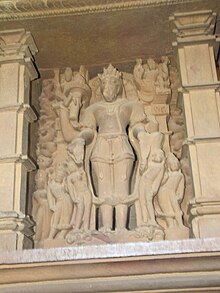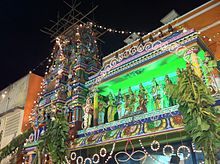Hayagriva
This article needs additional citations for verification. (December 2022) |
| Hayagriva | |
|---|---|
God of Wisdom[1] | |
 Painting of Hayagriva, Nataraja Temple, Chidambaram | |
| Other names | Hayashirsha |
| Sanskrit transliteration | Hayagrīva |
| Affiliation | Vaishnavism |
| Abode | Vaikuntha |
| Mantra | jñānānandamayaṃ devaṃ nirmala sphaṭikākṛtim / ādhāraṃ sarva viddyānāṃ hayagrīvaṃ upāsmahe // |
| Weapon | Sudarshana Chakra Panchajanya |
| Consort | Lakshmi |
| Part of a series on |
| Vaishnavism |
|---|
 |
Hayagriva (
Iconography

Hayagriva is an
Vedanta Desika's dhyāna-śloka (meditative verse) on Hayagriva typifies this deity's depiction in Hindu iconography:
He has four hands, with one in the mode of bestowing knowledge; another holds books of wisdom, and the other two hold the Conch and Discus. His beauty, like fresh cut crystal, is an auspicious brilliance that never decays. May this Lord of speech who showers such cooling rays of grace on me be forever manifest in my heart![5]
In several other sources he is a white horse who pulls the sun into the sky every morning. In others such as the great epic Taraka-battle where the demigods are fallen on and attacked by the Danava's [demons], Vishnu appears as a great ferocious warrior called Hayagriva when he comes to their aid. It says: "Hayagriva appears in his chariot, drawn by 1,000 powerful steeds, crushing the enemies of the gods beneath him!"[This quote needs a citation] There are many other references to Hayagriva throughout the Mahabharata.
It is said that Vishnu comes from battle as a conqueror in the magnificent mystic form of the great and terrible Hayagriva:
The great Hayagriva having been praised in this way by the different saints and ascetics, assumes a great white horses head. The verda’s [mantras] made up his shape, his body built of all the great demigods; in the middle of his head was Shiva, in his heart was Brahmā; the rays of sun (Marichi) were his mane, the sun and moon his eyes; the Vasus and Sadhyas were his legs, in all his bones were the demigods. Agni [Ka-ten; god of fire] was his tongue, the goddess Satya his speech, while his knees were formed by the Maruts and Varuna. Having assumed this form, an awesome wonder to behold to the demigods, he vanquished the asura, and cast them down, with eyes that were red with anger.[This quote needs a citation]
Invariably, Hayagriva is depicted seated, most often with his right hand either blessing the supplicant or in the vyākhyā mudrā pose of teaching. The right hand also usually holds a akṣa-mālā (rosary), indicating his identification with meditative knowledge. His left holds a book, indicating his role as a teacher. His face is always serene and peaceful, if not smiling. Unlike his Buddhist counterpart, there is no hint of a fearsome side in the Hindu description of this deity.
Hayagriva is sometimes worshiped in a solitary pose of meditation, as in Thiruvanthipuram Devanathasvami Temple. This form is known as Yoga-Hayagriva. However, he is most commonly worshipped along with his consort Lakshmi and is known as Lakshmi-Hayagriva. Hayagriva in this form is the presiding deity of Mysuru's Parakala Matha, a significant Sri Vaishnavism monastic institution.[6]
Legend
According to legend, during the period of creation, two demons Madhu and kaitabha stole the Vedas from Brahma, and Vishnu assumed the Hayagriva form to recover them. Yet another legend has it that during the creation, Vishnu compiled the Vedas in the Hayagriva form.
Hayagriva is listed as one of the ten incarnations of Vishnu in canto 10, chapter 40 of the Bhagavata Purana. In the text, Akrura's prayer contains Hayagriva's name when he had a vision while bathing in the Yamuna.[7]
The Mahabharata also features the legend of Hayagriva:[citation needed]
Having compassed the destruction of the two Asuras and restored the Vedas to Brahma, the Supreme Being dispelled the grief of Brahma. Aided then by Hari and assisted by the Vedas, Brahma created all the worlds with their mobile and immobile creatures. After this, Hari, granting unto the Grandsire intelligence of the foremost order relating to the Creation, disappeared there and then for going to the place he had come from. It was thus that Narayana, having assumed the form equipped with the horse-head, slew the two Danavas Madhu and Kaitabha (and disappeared from the sight of Brahma).
— Mahabharata, Book 12, Chapter 348
Worship
| Part of a series on |
| Vaishnavism |
|---|
 |




